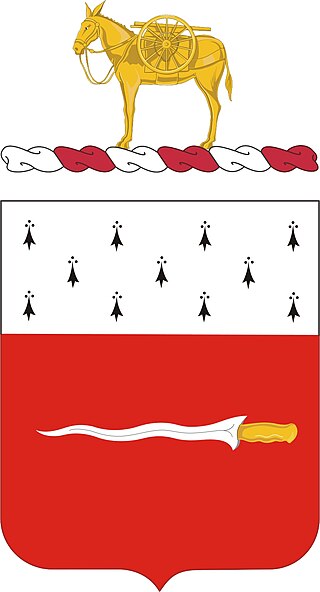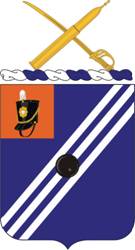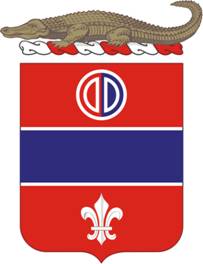
The 9th Infantry Division is an inactive infantry division of the United States Army. It was formed as the 9th Division during World War I, but never deployed overseas. In later years it was an important unit of the U.S. Army during World War II and the Vietnam War. It was also activated as a peacetime readiness unit from 1947 to 1962 at Fort Dix, New Jersey, and Fort Carson, Colorado, and from 1972 to 1991 as an active-duty infantry division at Fort Lewis, Washington. The division was inactivated in December 1991.
The 111th Field Artillery is currently constituted as a composite battalion consisting of two batteries of 105MM towed artillery and one battery of 155MM towed artillery (M777) unit with a general support/reinforcing mission. It is a unit within the Virginia Army National Guard based in Norfolk, Virginia.
The 150th Field Artillery Regiment is a field artillery unit in the Indiana Army National Guard.

The 5th Field Artillery Regiment was constituted as part of the Regular Army in January 1907. Individual battalions have lineages which date back further. Currently, it is a parent regiment under the U.S. Army Regimental System, with a single active battalion, the 1st Battalion, 5th Field Artillery, which is assigned to the 1st Brigade Combat Team, 1st Infantry Division at Fort Riley, Kansas.

The 2nd Field Artillery Regiment is a field artillery regiment in the United States Army. Currently a parent regiment under the U.S. Army Regimental System, the regiment has a single active battalion, the 2nd Battalion, 2nd Field Artillery, assigned to the 428th Field Artillery Brigade at the U.S. Army Field Artillery, Fort Sill, OK. Their long history is currently represented by the 2nd Field Artillery Mascots
The 3rd Field Artillery Regiment is a field artillery regiment of the United States Army, first formed in 1812, although regimental units trace their lineages as far back as 1794. Based on the service of these antecedents, the regiment claims battle honors for the War of 1812, the Seminole campaign, the Mexican War, the Civil War, the Spanish–American War, and the Philippine Insurrection. The regiment served with the 6th Division during World War I, with the 5th Division, 6th Division and 2d Cavalry Division between the world wars, and with the 9th Armored Division during and after World War II. Since 1961, the regiment has been a parent regiment under the Combat Arms Regimental System and the U.S. Army Regimental System, with regimental elements serving with the 1st, 6th, and 8th Infantry Divisions; 2nd and 3rd Armored Divisions; 1st Cavalry Division; 194th Armored Brigade; and various field artillery brigades and groups. Three regimental battalions are currently active: the 2nd Battalion in the 1st Armored Division and the 1st Battalion and 5th Battalion, both a part of the 17th Field Artillery Brigade.
The 8th Field Artillery Regiment is a field artillery regiment of the United States Army first formed in 1916. The regiment served in World War I, World War II, and Korea, and regimental units have served in Vietnam, Honduras, Panama, Operation Desert Storm, Operation Enduring Freedom and Operation Iraqi Freedom. Currently organized as a parent regiment under the U.S. Army Regimental System, the regiment's only active component is the 2nd Battalion, 8th Field Artillery Regiment, currently assigned to the 1st Infantry Brigade Combat Team, 11th Airborne Division and stationed at Fort Wainwright, Alaska.
The 9th Field Artillery Regiment is a field artillery regiment of the United States Army first formed in 1916. The regiment served in Hawaii during World War I, 3rd, 4th, 7th, and 9th Divisions between the world wars, and with 3rd Infantry Division during World War II and Korea. Since 1957, the regiment has been a parent regiment under the Combat Arms Regimental System and the U.S. Army Regimental System, with regimental elements serving with the 3rd, 4th, 10th, 25th, 79th, 83rd, and 96th Infantry Divisions and various field artillery brigades and groups. The regiment's single active component, the 1st Battalion, 9th Field Artillery Regiment, is assigned to the 2nd Brigade Combat Team, 3rd Infantry Division and stationed at Fort Stewart, Georgia.

The 41st Field Artillery Regiment is a field artillery regiment of the United States Army.

The 76th Field Artillery Regiment is a field artillery regiment of the United States Army. First formed as a cavalry regiment in 1916, the regiment was converted to field artillery in 1917, and served in Europe during World War I with the 3rd Division and as a separate battalion during World War II, as well as in peacetime at Fort Knox, KY, and Fort Devens, MA. Since 1959, the regiment has been a parent regiment under the Combat Arms Regimental System and the U.S. Army Regimental System, with regimental elements serving with the 3rd Infantry Division in Germany and Operation Iraqi Freedom, with the 7th Infantry Division in Korea, and in the Army Reserve. No regimental elements are currently active.

The 157th Field Artillery Regiment (First Colorado) is a United States Army Regimental System field artillery parent regiment of the United States Army National Guard, represented in the Colorado Army National Guard by the 3rd Battalion, 157th Field Artillery Regiment, part of the 169th Field Artillery Brigade at Colorado Springs.

The 84th Field Artillery Regiment is a field artillery regiment of the United States Army.

The 116th Field Artillery is a regiment of the Florida Army National Guard. Currently there are two battalions; 2-116th FA is fires battalion for the 53rd Brigade Combat Team, and 3-116th (HIMARS) is part of the 164th Air Defense Artillery Brigade, both of the Florida Army National Guard.
The 82nd Airborne Division Artillery (DIVARTY) is the divisional artillery command for the 82nd Airborne Division of the United States Army, stationed at Fort Liberty, North Carolina. It was organized in 1917, during World War I, was inactivated in 2006 as part of the transformation to modular brigade combat teams, and was reactivated in 2014.

The 2nd Battalion, 27th Field Artillery Regiment is an inactive field artillery battalion of the United States Army, last assigned to the 3rd Armored Division Artillery before its inactivation in 1988. Its parent regiment is the 27th Field Artillery Regiment.

The 1st Armored Division Artillery (DIVARTY) is the divisional artillery command for the 1st Armored Division at Fort Bliss, Texas. The DIVARTY has served with the division in World War II and the first Persian Gulf War, and in peacetime at Fort Hood, Fort Bliss, Fort Polk and Germany. The DIVARTY was inactivated in 2007 as part of transformation to modular brigade combat teams, but was reactivated in 2014 to provide fire support coordination and mission command for the training and readiness of field artillery units across the division.

The 2nd Infantry Division Artillery (DIVARTY) or "Warrior Strike" is the Force Field Artillery Headquarters for the 2nd Infantry Division. The DIVARTY served with the division from 1917 to present, including combat service in World War I, World War II, and the Korean War. In addition to peacetime service with the division at Fort Lewis, Washington, Fort Benning, Georgia, and in Japan and Alaska, the DIVARTY spent 40 years in Korea. After seven years stationed at Joint Base Lewis–McChord, where the DIVARTY provided fire support coordination and mission command for the training and readiness of five field artillery battalions, the Army restationed the DIVARTY to Camp Humphreys on 16 September 2021.
The 1st Cavalry Division Artillery (DIVARTY) or "Red Team" is the Force Field Artillery Headquarters for the 1st Cavalry Division. The DIVARTY served with the division from 1941 to 2005, including combat service in World War II, the Korean War, the Vietnam War, Operations Desert Shield and Desert Storm, and Operation Iraqi Freedom and in peacetime in Japan, Korea, and Fort Hood, Texas. As the Force Fires Headquarters, the DIVARTY provides fire support coordination and mission command for the training and readiness of field artillery units across the division.

The 10th Mountain Division Artillery (DIVARTY) is the divisional artillery command for the 10th Mountain Division. The DIVARTY served with the division from 1942 to the present, including fighting in World War II, Somalia and in Afghanistan and Iraq, and in peacetime in Germany; Fort Benning, Georgia; Fort Riley, Kansas; and Fort Drum, New York.

The 1st Battalion, 76th Field Artillery Regiment is an inactive field artillery battalion of the United States Army. The battalion has been assigned to the 3rd Infantry Division, 7th Infantry Division, 2nd Infantry Brigade, and as a separate field artillery battalion. The battalion has participated in World War I, World War II, Operation Iraqi Freedom, and Operation Enduring Freedom. The battalion inactivated in 2015 as part of Army force reductions.













